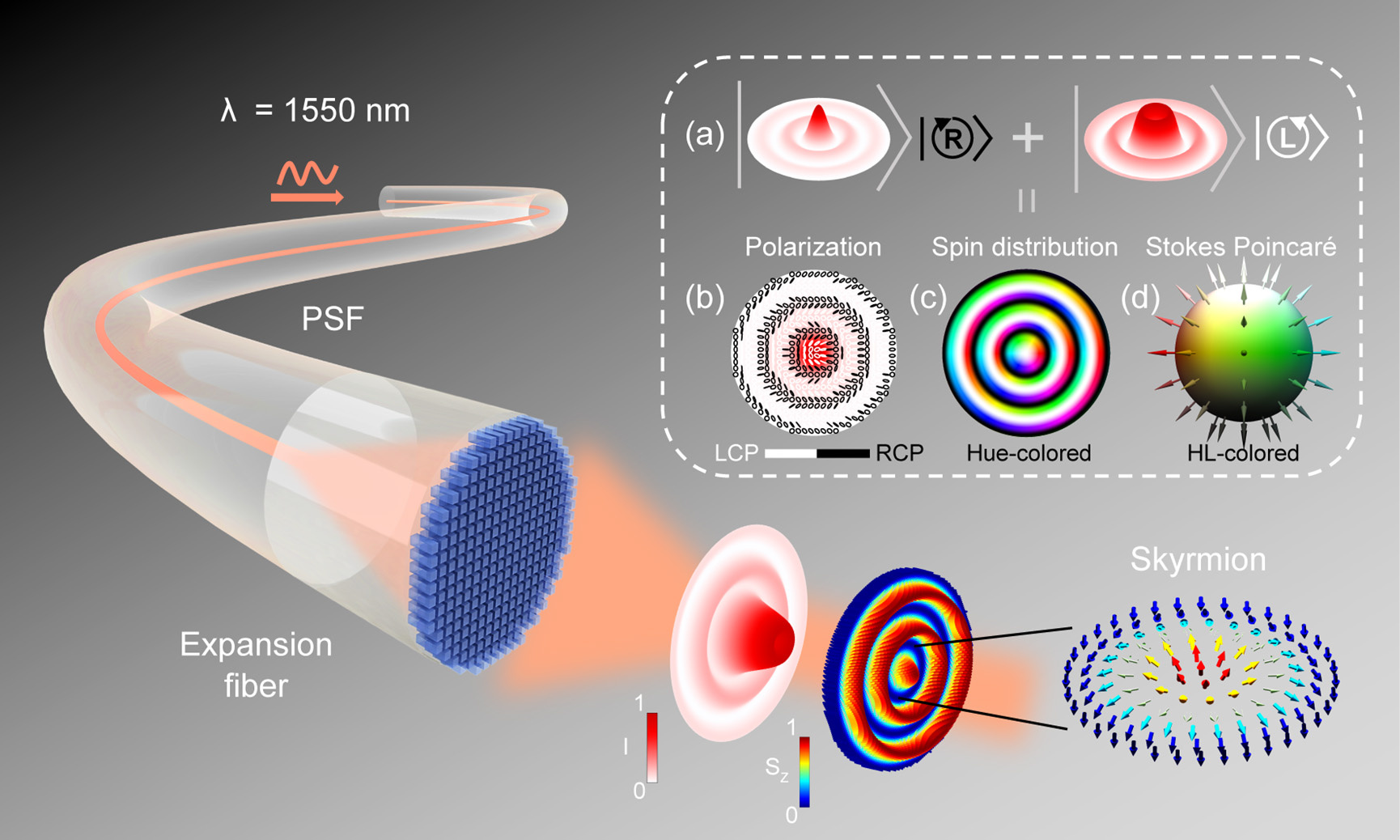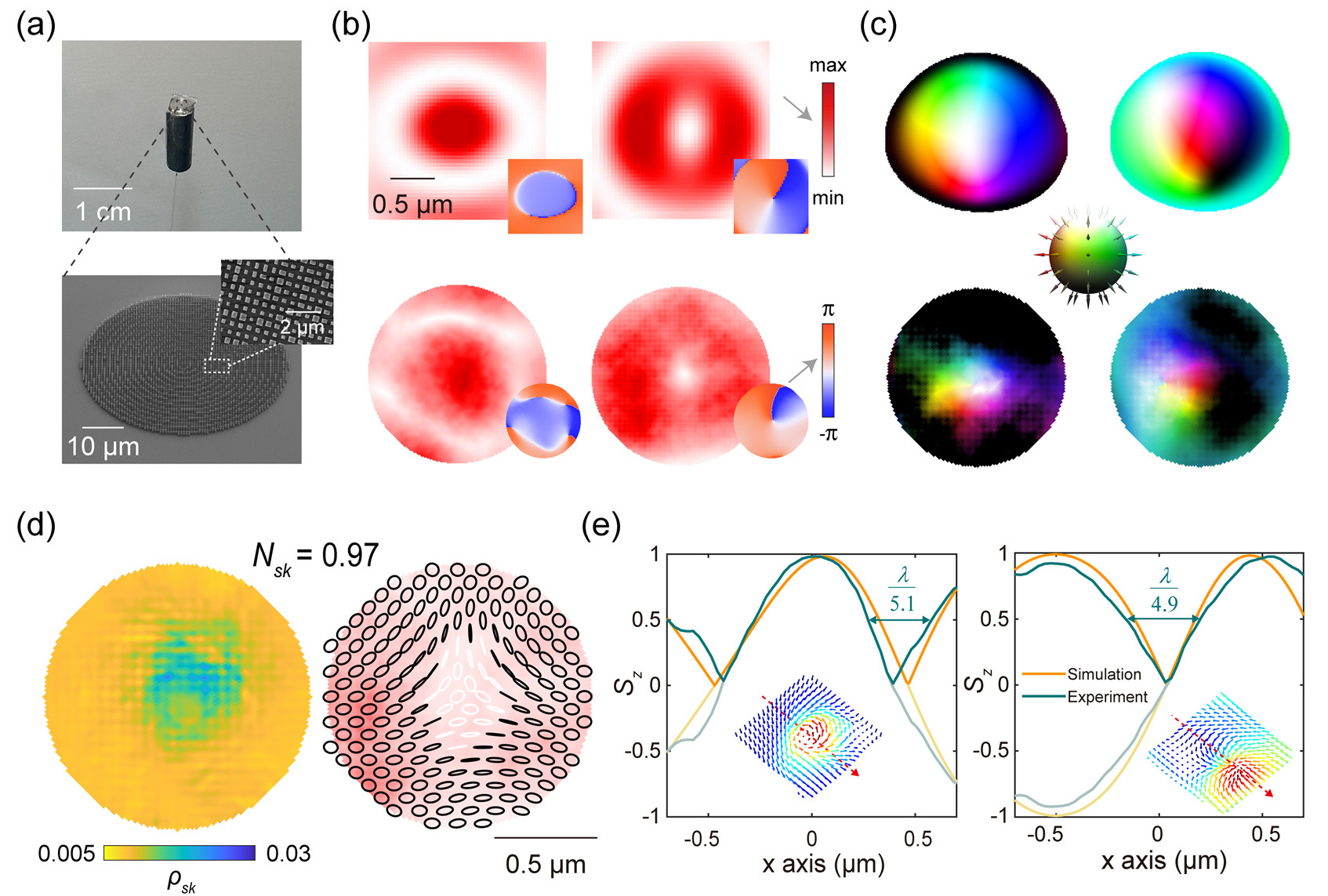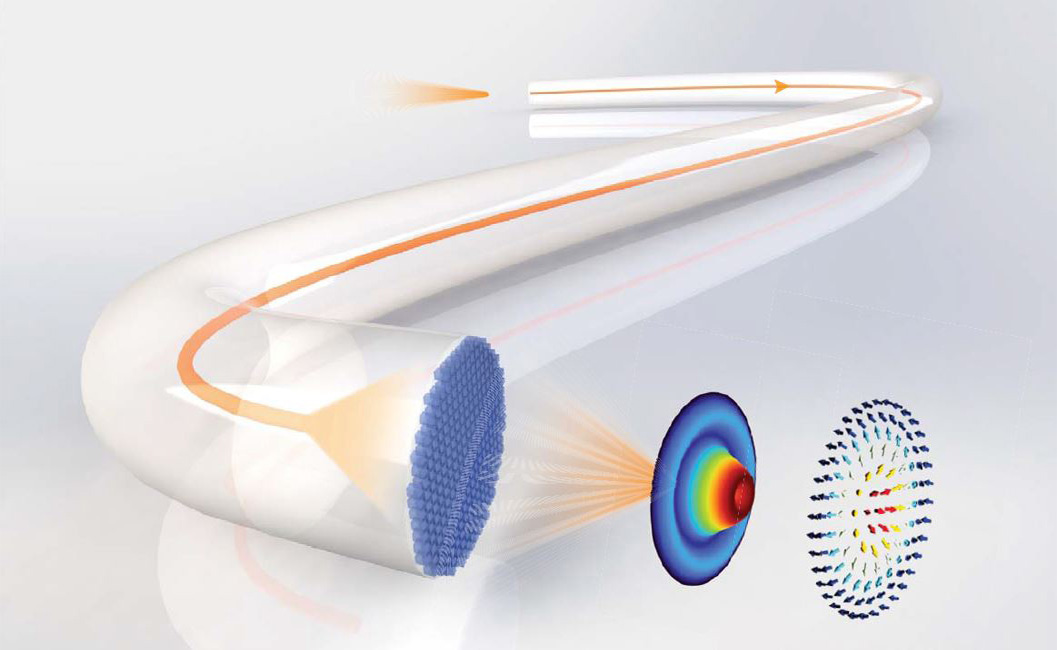Meta-fiber tips generating designer diffractionless optical skyrmions

Skyrmions are a class of topological quasiparticles with sophisticated spin textures, originating from particle and solid-state physics with various intriguing attributes as emerging information carriers in local data storage [1]. Recently, its photonic counterpart, optical skyrmions are a novel family of topologically structured light promising the revolution of next-generation optical information technologies [2].
However, current generation methods of optical skyrmions require complex or bulky spatial light modulation systems, hindering the emergence of further practical applications. Despite that some previous literatures utilized evanescent [3] or magnetic fields [4] to construct optical skyrmions, these approaches are limited to optical near fields, making the generated skyrmions difficult to detect and extremely challenging to propagate over long distances. In free space optics, the optical skyrmions were previously believed to be not feasible to achieve beams at subwavelength scales without using large-scale spatial light modulators.
Here, we present an integrated flexible meta-device as optical skyrmion generators capable of generating optical skyrmions with almost arbitrary topological textures and unique subwavelength polarization features. Inspired by the "lab-on-fiber" technology [5, 6] to provide a flexible and practical solution to produce structured light field with sophisticated topological properties. By engineering meta-structures on fiber-tips, the space-polarization nonseparability of the customized vector beams in orthogonal polarizations occurs in the near-field of fiber facet, therefore exciting the optical skyrmions with designer-controlled topologies.

The schematic diagram of the metafiber-based skyrmion generators is illustrated in Fig. 1, consisting of a polarization-maintaining single-mode fiber (PSF), an expansion section, and a single layer metasurface on the fiber-tip. As optical skyrmion is a quasiparticle state of light with distinctive topological vector textures, it can be constructed by polarization Stokes vectors of a customized vector beams. Here by superimpose two judiciously modulated orthogonally polarized Bessel beams (BBs) : zeroth-order BB (J0) and first-order BB (J1) carrying orbital angular momentum (OAM), in right-handed and left-handed circular polarizations respectively, a Stokes skyrmion is constructed (Fig. 1a and Fig. 1 insets).
By changing the design of the metasurface resting on the fiber-tip, various types of optical skyrmions with different topological textures can be generated, such as Néel-, Bloch-, and Anti-types etc. (please refer to the Fig. 2 in the original article for details). The experimental verification results are summarized as Fig. 2 below. Notably, the skyrmions experimentally generated by our schema achieves skyrmion number up to 0.97, revealing a nearly-full skyrmion map on Poincaré sphere showing excellent quality. A subwavelength polarization feature in our generated Stokes skyrmions is both numerically and experimentally verified to be down to ~λ/5, where λ represent light wavelength, providing a paradigm for easily detectable solution for free-space propagating optical skyrmions with diverse topological polarization features.

In conclusion, we have demonstrated the ultracompact and flexible generators of optical Stokes skyrmions using metafibers, with various available designer topological textures, subwavelength polarization features, and robust propagation diffraction resilience. Further exploration of the proposed platform can be extended to spin skyrmions, and phase-change or 2D-materials-enpowered reconfigurable metasurface/ meta-photonics skyrmions generators [7, 8]. The study of diversified topologies of electromagnetic light fields in ultracompact devices for generating arbitrary optical quasi-particles with topology protection as well as other designer structured light fields, paving the way of practical applications of optical skyrmions.
Article Information
Tiantian He†, Yuan Meng†, et al. Optical skyrmions from metafibers with subwavelength features. Nature Communications 15, 10141 (2024).
DOI: 10.1038/s41467-024-54207-z
Article link: https://www.nature.com/articles/s41467-024-54207-z
References
[1] M. T. Birch, et al. Dynamic transition and Galilean relativity of current-driven skyrmions. Nature 633, 554–559 (2024).
[2] Y. Shen, et al. Optical skyrmions and other topological quasiparticles of light. Nature Photonics 18, 15–25 (2024). https://www.nature.com/articles/s41566-023-01325-7
[3] L. Du, et al. Deep-subwavelength features of photonic skyrmions in a confined electromagnetic field with orbital angular momentum. Nature Physics 15, 650–654 (2019).
[4] Y. Shen, et al. Supertoroidal light pulses as electromagnetic skyrmions propagating in free space. Nature Communications 12, 5891 (2021).
[5] Y. Meng, et al. Optical meta-waveguides for integrated photonics and beyond. Light: Science & Applications 10, 235 (2021). https://www.nature.com/articles/s41377-021-00655-x
[6] M. Principe, et al. Optical fiber meta-tips. Light: Science & Applications 6, e16226 (2017).
[7] Y. Meng, et al. Photonic van der Waals integration from 2D materials to 3D nanomembranes. Nature Reviews Materials 8, 498-517 (2023).
[8] H. Tang, et al. On-chip multi-degree-of-freedom control of two-dimensional materials. Nature 632, 1038–1044 (2024).

Follow the Topic
-
Nature Communications

An open access, multidisciplinary journal dedicated to publishing high-quality research in all areas of the biological, health, physical, chemical and Earth sciences.
Your space to connect: The Polarised light Hub
A new Communities’ space to connect, collaborate, and explore research on Light-Matter Interaction, Optics and Photonics, Quantum Imaging and Sensing, Microscopy, and Spectroscopy!
Continue reading announcementRelated Collections
With Collections, you can get published faster and increase your visibility.
Women's Health
Publishing Model: Hybrid
Deadline: Ongoing
Advances in neurodegenerative diseases
Publishing Model: Hybrid
Deadline: Dec 24, 2025






Please sign in or register for FREE
If you are a registered user on Research Communities by Springer Nature, please sign in